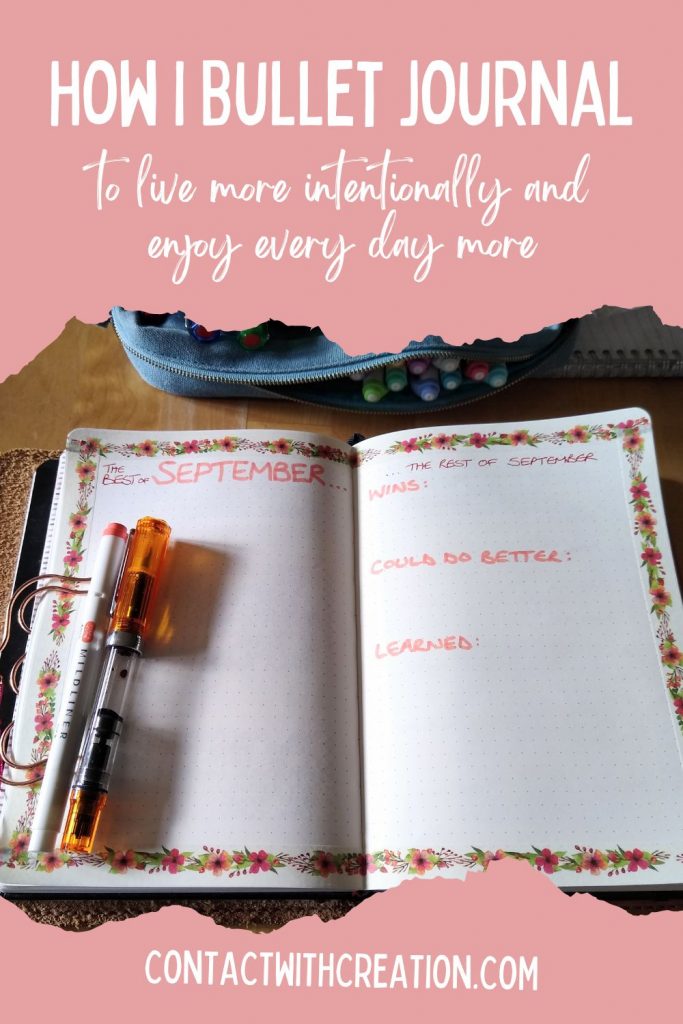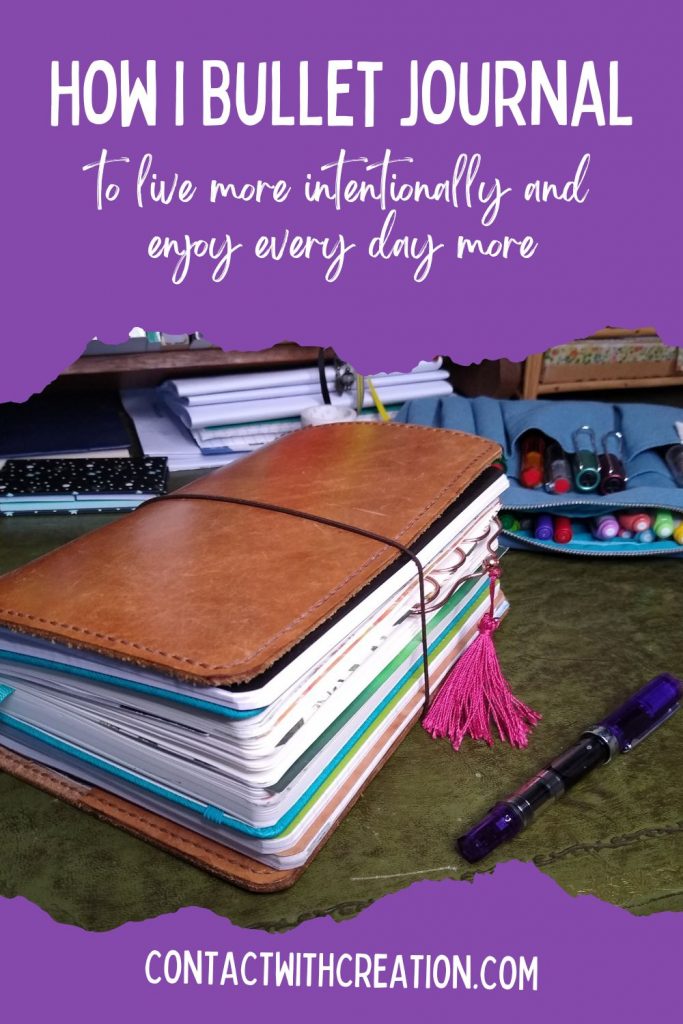Starting a bullet journal changed my life. Five years ago this month, I looked back at my year and I saw… nothing. It was hard to remember what I’d achieved or what I’d enjoyed, or anything much that had happened. I wasn’t really working towards anything and I didn’t really know what I wanted anyway. I was just drifting through life. Not doing nothing, but not paying attention either. Just going through the motions and taking everything as it came.
What a waste!
With the perfect timing of divine intervention, bullet journalling arrived in my consciousness by chance the following week. There I was, idly browsing YouTube videos about minimalism, and a bullet journalling video popped up. And it spoke to me instantly. This was an easy way that I could be more organised and more purposeful about my day-by-day doings. I had to give it a try.
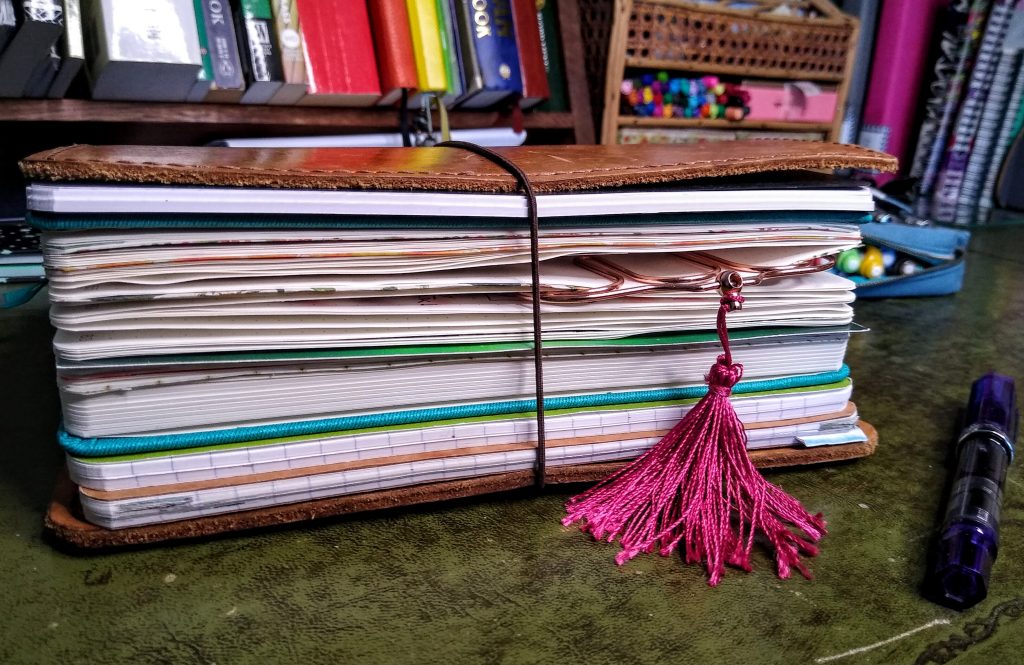
BENEFITS OF A BULLET JOURNAL
Five years on, my bullet journal has improved my life in so many ways that I can hardly remember what life was like without it. How did I get anything done? What was I doing with my life back then? I really have no idea.
Here are some of the benefits it has brought me:
PRODUCTIVITY
The core of my bullet journal is a daily to-do list, making sure I stay focused and don’t forget things. There’s room to plan future tasks too, and anything that gets missed is easily carried over to the next suitable day.
A CLEARER HEAD
When you’re trying to remember lots of things, or you have a lot on your mind, the feeling can really clog up your thoughts and weigh you down. The bullet journal is a catch-all for my thoughts and to-dos, and I can jot anything in at any time. This keeps my mind clearer and ensures nothing gets forgotten.
GRATITUDE
My bullet journal doubles as a gratitude journal, reminding me to count my blessings each day. It helps me to see over time how enormously blessed I am.
HAND-WRITING
These days we type almost everything. But writing by hand has loads of benefits, including making us more mindful, calming us, helping us to order our thoughts, and boosting creativity. It has certainly improved my handwriting too, and I enjoy it!
STREAMLINING
Before my bullet journal, life was full of messy and disorganised notebooks and random scraps of paper. I’d jot things down anywhere, and waste ages trying to find them again later. But now, everything is in one place and I know exactly where to find it!
PLANNING AHEAD
Thanks to bullet journalling, I am much more intentional about life and how I want my life to be. I think more about experiences I want to have, things I want to learn, and places I want to go. It empowers me to choose what’s ahead instead of just letting things happen, and gives me more control.
ACHIEVING GOALS
Similarly, a bullet journal is an excellent place to track progress towards goals. Setting goals for each year and each month keeps me always growing and moving in the right direction.
LOOKING BACK
My bullet journal records what I do each day, including places I went, things I enjoyed, and stuff I learned. For the first time, I can look back in helpful detail at periods of my life. At the end of each month I review what happened and make a note of what I achieved. At the end of the year I review again, and can see what value the year added to my life.
A SENSE OF STORY
Humans are natural storytellers. We’re uniquely sensitive to cause and effect, ambition and fulfillment, and we tell ourselves stories about our lives and ourselves all the time. Bullet journalling has helped me to grasp better a sense of my own direction, and to build momentum towards the life that I want. Every story has its ups and downs, so even when things don’t go my way, I can see how it’s all adding up to the story of me.
“Writing things down allows us to capture our thoughts and examine them in the light of day. By externalizing our thoughts, we begin to declutter our minds.”
Ryder Carroll, The Bullet Journal Method
HOW TO BULLET JOURNAL
If you search bullet journal images on YouTube, Pinterest or Google you’ll see a feast of colour and design: notebooks filled with carefully-drawn boxes for each day, elaborate colour codes, stickers and post-its galore, and artful drawings adorning each page. You’ll see decorated monthly title pages, habit trackers, mood trackers, exercise trackers, and lists for everything you can think of.
That is NOT what I’m here to tell you about. It is not among my priorities to have a beautiful bullet journal: the bullet journal itself is not my goal. Instead, it’s a tool to help me towards my goals. Creative journalling like that might work for some people, but it takes an enormous amount of time, diverts creative energy that I’d like to spend elsewhere, and in my opinion loses sight of all the best elements of the method and its simple beauty.
The ‘bullet’ in bullet journalling refers to bullet point lists. It’s that simple.
It was the brainchild of Ryder Carroll, who developed it for his own use and unleashed it on the internet in 2013. In this four-minute video he explains the method:
So that’s the basics. But one of the great things about bullet journalling is that it’s enormously customisable. I am sure no two bullet journals are the same, and in five years I have seen, tried or developed hundreds of tips, hacks and add-ons – some I still use now and plenty I don’t.
So here’s how I use MY bullet journal.
MY BULLET JOURNAL SET-UP
DAILIES
Dailies are the essence of my bullet journal and take up most of the pages. They hold my to-do list and any notes that come up throughout the day. I use the recommended bullets: a dot for a task, a circle for an appointment or event, a dash for a note, forward and back arrows to indicate migration, and a star next to must-do or highest priority tasks. To cancel a task, I put a line through it.
In addition, I use a + to record to-dos for future days. This allows me to jot down jobs for tomorrow or next week while clearly showing they are NOT immediate priorities.
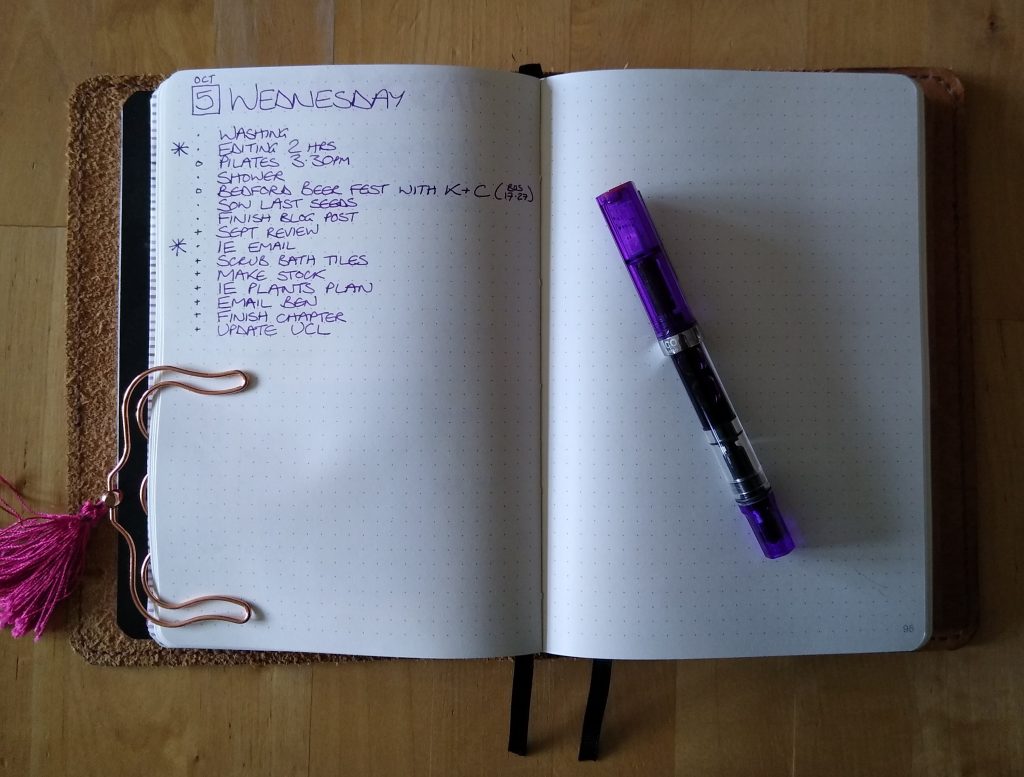
COLOUR-CODING
A bullet journal doesn’t require any colour at all. But colour is basically one of my favourite things in the world, so I write with a purple pen, because I like it, and look for opportunities to use other colours too. This results in a loose colour code: purple for the main tasks/events part of my list, then blue for gratitude, light green for nature observations, dark green for community garden notes, pink for fun stuff, orange for media (e.g. films watched, games played), and teal for learning and reading (e.g. books read, podcasts, things learned).
Oh, and red for bad stuff and money stuff. Hmmm, that’s some really unhelpful psychology right there. I guess I need another colour…
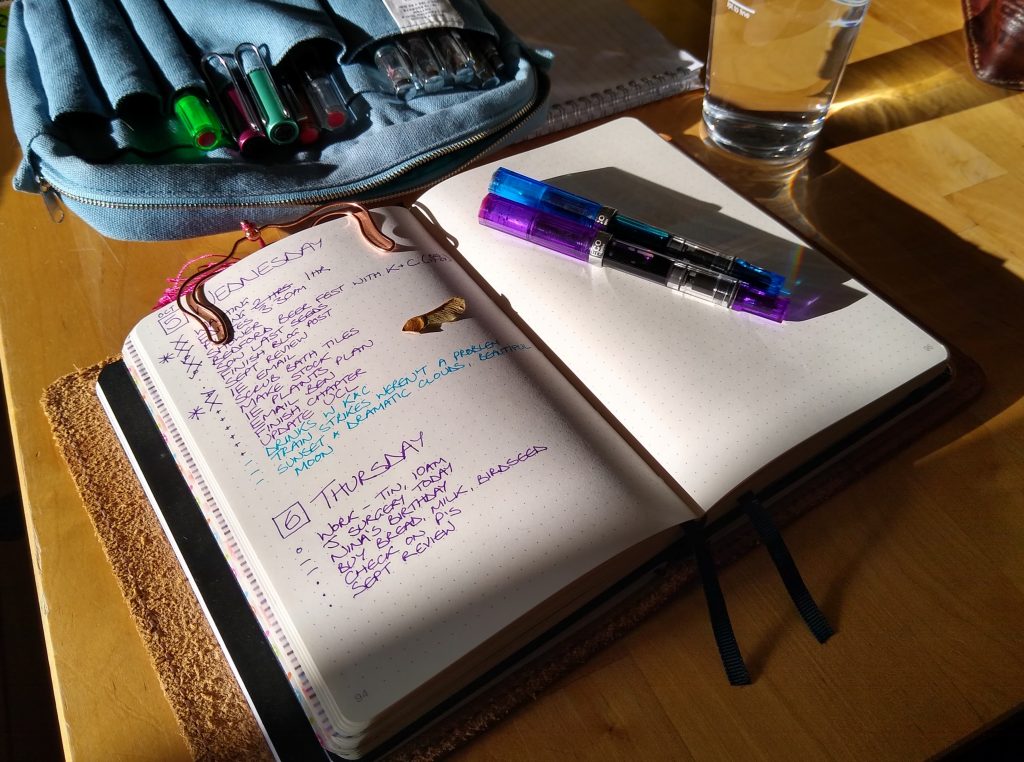
I started off using Staedtler’s Triplus Fineliners. They’re brilliant, but when they ran out I felt guilty about the plastic I was throwing away and replacing, possibly ad infinitum… So over time, I moved to piston-fill fountain pens instead, which are refilled directly from a bottle without cartridges. They cost a bit, but will last for years and years, and the ink colour options are virtually endless! My favourites are TWSBI eco, which are made of virtually-indestructible acrylic and come in lots of colours. I also have some Lamy Al-Stars, with convertors to eliminate the need for cartridges.
Okay, I confess. I have a handful of felt-tip pens too (Crayolas and Mildliners) for writing bold titles and stuff. But they last MUCH longer because they’re only for occasional use. My awesome pen case is by Delfonics!
TIP-INS AND MEMENTOS
Sometimes I like to stick in photos, flyers and tickets for stuff I’ve done and places I’ve been. I never had anywhere to put these mementos before – if anything they just got chucked in a drawer and forgotten about. Now they serve as part of an organised record, and I love looking back on them.
MY ROUTINE
Each morning, or sometimes the night before, I write the task list for the day. This could be any combination of appointments and work, tasks arising naturally on the day, tasks which are regular for that day of the week, tasks migrated from previous days, and tasks from my monthly log.
As I go through the day, I mark off what I’ve done by crossing the bullet with an X, and add new things as needed. When I write the next day’s list, I migrate, as appropriate, any undone tasks to the new list by copying them across and marking the old with a forward arrow. I usually only migrate tasks from previous days to the current day if I intend to do them.
On Mondays, however, all left-behind tasks (as long as they’re still important) get carried forward to the new week. This way Monday’s log becomes a kind of master-list for the week and nothing gets left behind. So Mondays will usually list a bunch of tasks for today AND a bunch of tasks for later in the week.
If I’ve worked on a task but not finished, I’ll edit the text to say so. Then I’ll BOTH mark it as done and migrate it to a new day to finish it – this shows that I worked on it.
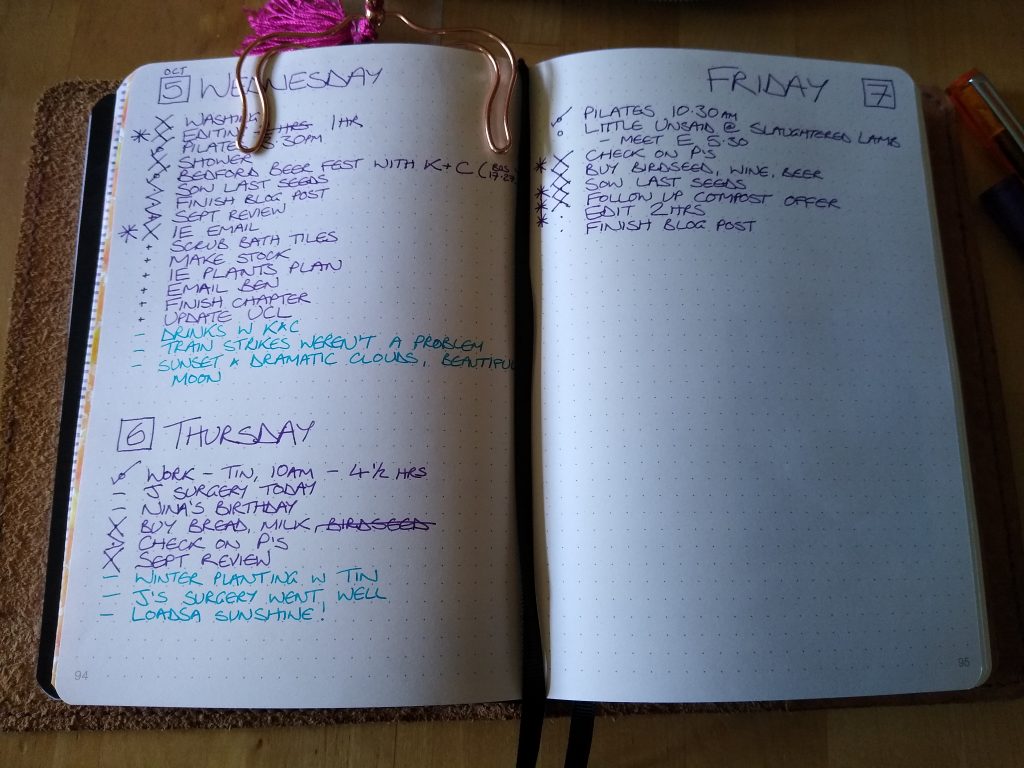
NO WEEKLIES
In a break from the original method, a lot of people like to use one double-page spread for a week, spacing it out on the page in advance and then filling in the week’s notes and tasks as they go, so that they can see the whole week as a unit.
But my daily rapid-logging takes up much more space than this, so my week usually lasts four pages (two spreads). A pre-drawn weekly spread would severely limit how many tasks and notes I could write down, so weeklies are a no-go for me. It would also take a lot of extra time to set it up at the start of each week. If I wanted a week-to-view diary, I’d just buy one!

MONTHLIES
I use a monthly log just like in the original method. A lot of people prefer a calendar-style grid, but I like the linear style and it’s MUCH quicker to set up. It also has plenty of space for a master task list on the facing page.
I never stress about what page it falls on. When I feel like it’s time to bring the next month into focus (usually about a week before it begins) I estimate where my dailies for the current month will end, leave a double-page for my monthly review, and then create the monthly. Sometimes it means I end up with the first couple of dailies of the new month tagged onto the previous month, or vice versa. That’s okay with me.
I populate my monthly log with the tasks and events in my future log, my Google calendar, items left over from the previous month, and anything else that occurs to me as I go.
I always put a strip of washi tape (decorated paper tape) on the edge of my monthly log, sticking out a little, so that I can easily find it and turn to it.
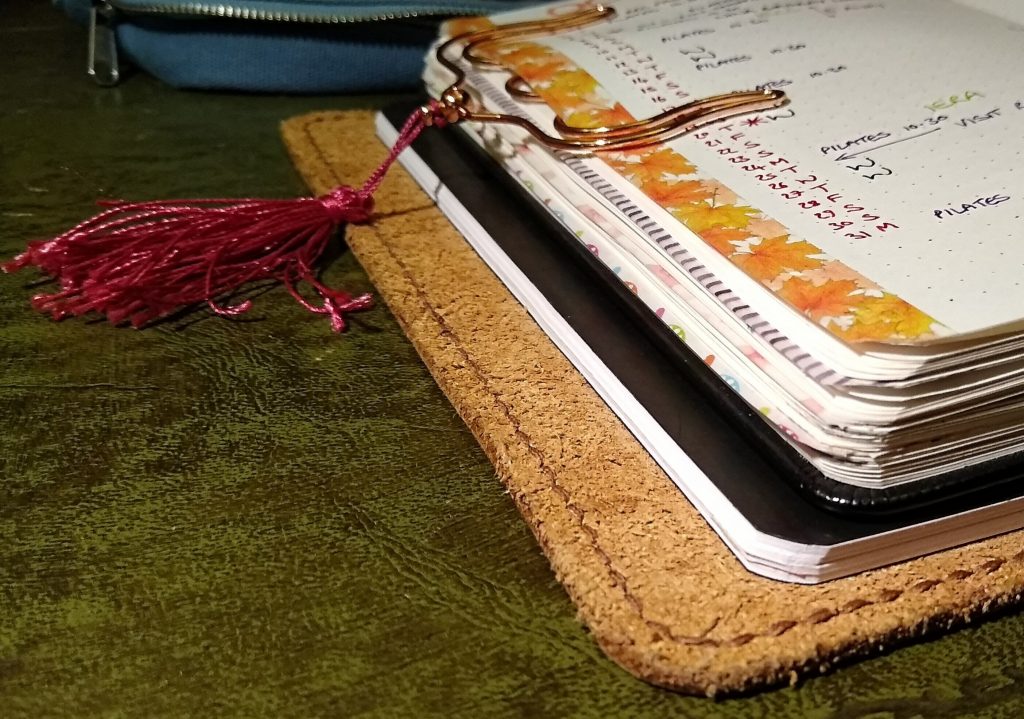
MONTHLY REVIEW
This takes a bit of extra time, but for me is a crucial part of my bullet journal. It helps me to look at whether I’m getting ‘enough’ out of life, whether I’m being true to my intentions, and what I need to work on next month. I record highlights under a few headings, as shown below. If anything else really significant happened during the month I might add that too.
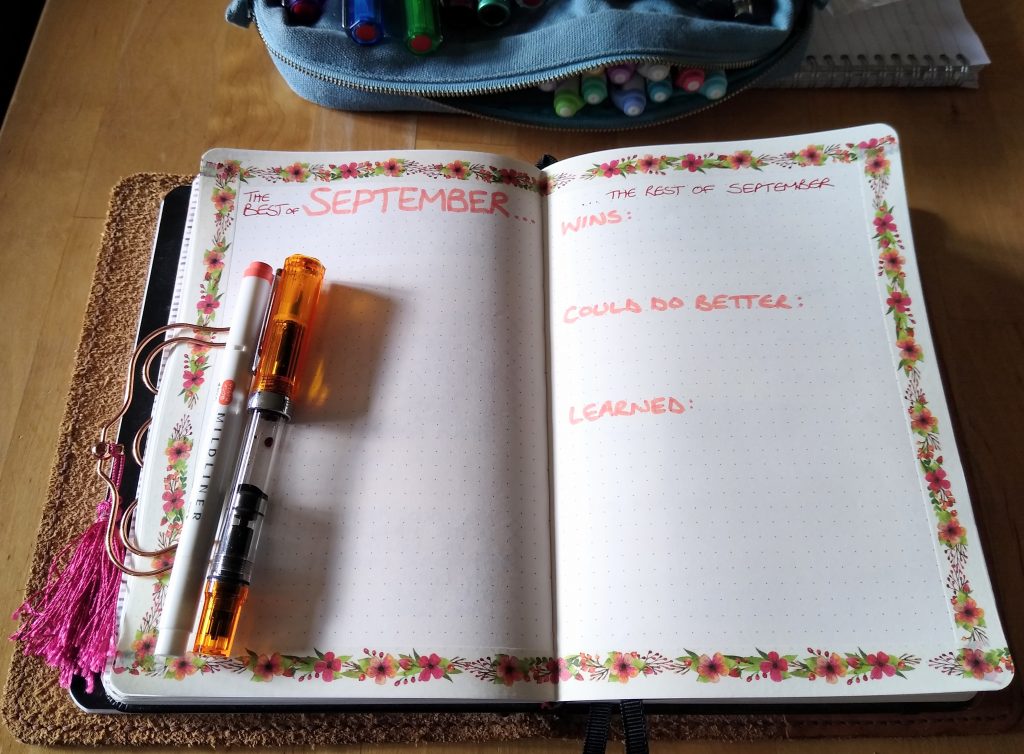
FUTURE LOG
The future log in the original method didn’t work for my brain. I wanted to be able to see at a glance how events fitted into each month. So I quickly moved to a compact version of the monthly pages for my future log. Each December I set this up for the new year, fitting three months plus a notes column to each double page. There’s not much room for detail, so at the beginning of each month when I copy relevant information from the future log to a monthly log, it’s like bringing the month into focus and fleshing it out.
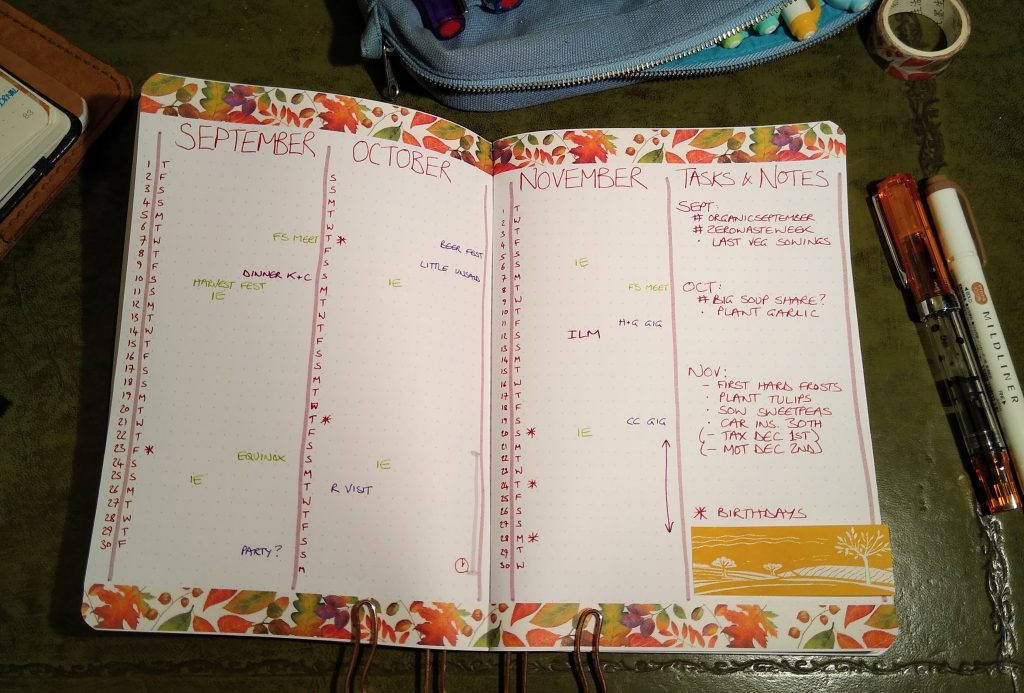
For any dates beyond the current year, I just keep a single blank page entitled ‘Next Year’ to jot them down.
THREE NOTEBOOKS, ONE COVER
After my first few bullet journals, I realised I had several information-holding spreads that I wanted always to hand – stuff like birthday dates and seasonal recipe lists and insurance details – and several that I wanted to last all year, like a weight and exercise tracker and goal-tracking pages. With daily rapid-logging, my notebooks only lasted 6-9 months, so copying this stuff into every new notebook sucked. So I splashed out on a journal cover (from Meadowgate Leather) that would hold several notebooks together.
Now three notebooks make up my bullet journal. At the front, there’s a slim annual notebook for my future log, weight tracker, goals and a few other things. In the middle is my main everyday bullet journal. And at the back, I have a ‘permanent’ notebook for long-term useful information and ongoing lists. Typically I keep a writer’s notebook in here too. I love it!
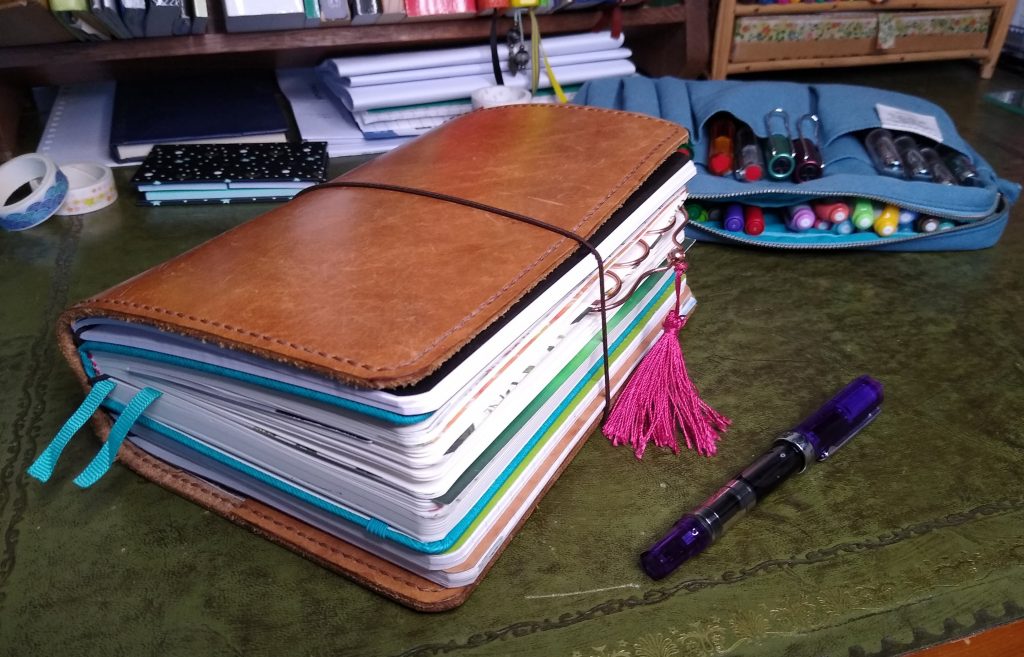
I’ve tried a few different notebooks for my bullet journal, but these days I stick with my favourite by Perfectly Penned. It has 255 numbered pages (dotted or lined) of high-quality paper (120gsm, with very little ghosting from the other side), and it has two bookmarks and a useful pocket inside the back cover. And it comes in some lovely colours! For my annual notebook I usually use a Rhodia A5 dotbook, and for my long-term spreads a Clairefontaine A5 Age Bag notebook – both chosen for great paper and a large number of pages. (Want to know where I got my super-useful page holder? It’s here.)
TRACKERS
Bullet-journalling is often associated with lots of trackers, for mood, good habits, wellness, housework and all sorts of things. I’ve tried a lot of trackers in my five years of bullet journalling, but most fall by the wayside. Filling in a bunch of trackers each day is a tricky habit to master, and can easily be a distraction from what’s truly important.
There are a few trackers I’ve stuck with, however:
- I track my weight weekly, because staying aware of it makes me more conscious of healthy habits. Alongside that, I track my weekly steps from my Fitbit, so that if I start to get lazy I notice.
- A monthly tracker for my good intentions set at the start of the year. This reminds me to live life the way I’d like to and work towards my goals.
- A ‘When Did I Last…?’ page for infrequent jobs like cleaning out the freezer and backing up my computer.
- A ‘Someday Maybe’ list of ideas, ambitions and pipe-dreams for the future.
- Annual lists of films watched, books read, videogames played, new music discovered, and restaurants and shows/gigs attended, just because I enjoy keeping a record and looking back on it later. And a list of new recipes to help me remember to make them again!
As mentioned above, trackers go in my annual notebook and not my daily bullet journal. That way I can see a year’s worth as a unit without copying them out again when I need a new journal.
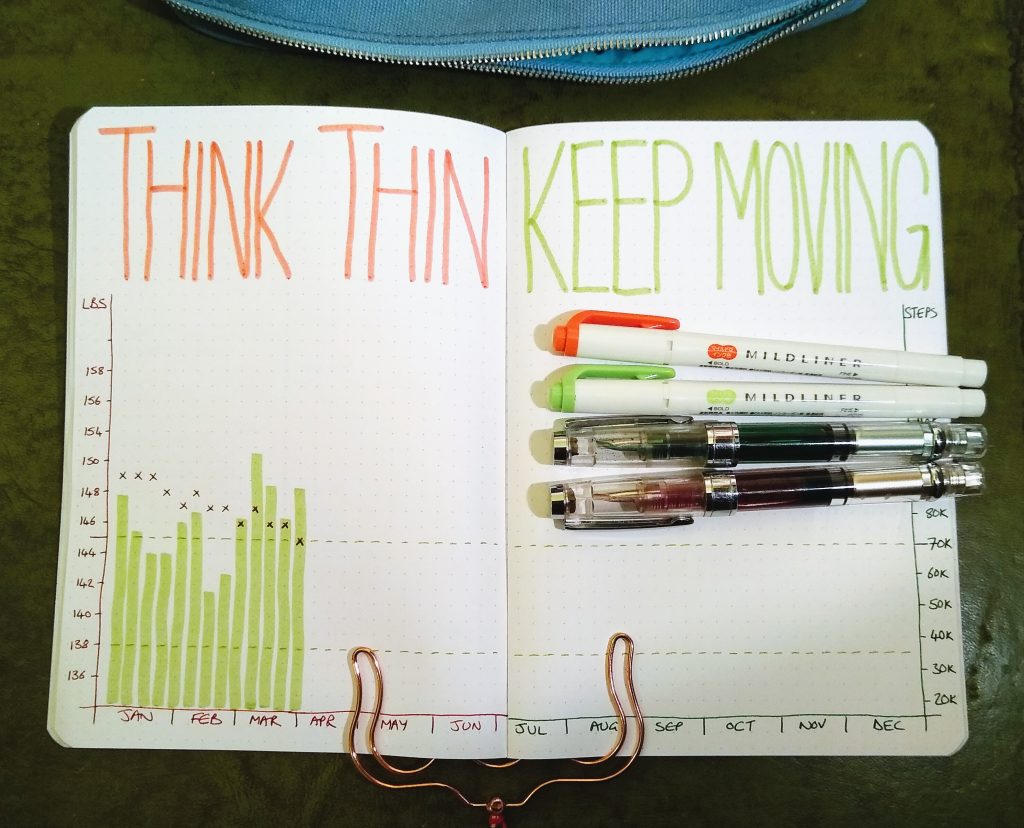
COLLECTIONS
Collections, for me, tend to be of three types. Some track specific projects – I have to be careful though to remember it’s there and turn to it regularly. Some keep notes on books I’d like to remember. (These two types usually go in my main daily bullet journal.) The third type holds long-term info, e.g. friends’ birthdays, details about the car, seasonal meal ideas, and an annual garden schedule. (These go in my long-term notebook.)
HOW TO START A BULLET JOURNAL
Want to start a bullet journal and try it out for yourself? It’s so easy!
1 – Watch the video above if you haven’t already.
2 – Grab a notebook and a pen. There are plenty of additional supplies you might end up using too but these are the only essentials.
3 – Set the first double page spread aside for your index. Write INDEX at the top! Turn the page.
4 – Create a future log (see the video or my example above) and enter significant dates and deadlines. Add it to the index. Turn the page.
5 – Create a monthly log for the current month (see the video or my example above – or other examples online). On the facing page (or a new page) enter all your tasks and reminders for the month. Add it to the index!
6 – Rapid-log today. On the next available page, write today’s date and make a bullet-list of all your tasks and reminders for today. Start with the recommended bullet point symbols, and adjust them if required as you get used to the system. You don’t need to add dailies to the index.
7 – Assess your goals. If you need some help thinking clearly about your goals and getting organised to live more intentionally, Ryder Carroll suggests a mental inventory: it’s a great tool to get your thoughts in order and I’ve found it really useful. Divide a sheet of paper into three columns: one for what you are currently working on, one for what you should be working on, and one for what you want to be working on. Now populate those columns, and get all your thoughts down into them.
When you’re done, ask yourself if each one actually matters to you (or to someone else that matters to you), or if it is vital. If any item is a NO on both points, it’s just a distraction. Cross it off!
Also see my post on goal-setting: Goal Setting in Uncertain Times.
8 – Consider trackers or collections you’d like to create to help you work towards your goals. Remember to add them to the index.
9 – Use your journal regularly! Each day, don’t forget to add the day’s do-list, cross off what you have done and carry forward any missed tasks as appropriate. Once a week, check back on any missed tasks and make sure they’re still meaningful or vital. Cancel any that are not, and migrate any that are to the current week so that they don’t get forgotten.
And you’re off!
MY BULLET JOURNAL DOS AND DON’TS
DON’T delay! The perfect time is now! You don’t need to start at the beginning of a year, month, or week, and you don’t need anything special to get started. Any notebook and any pen will do. Dotted notebooks are often used, but it’s really just a trend. My first two bullet journals were lined and I preferred that. I only switched to dots because I wanted to list 31 days vertically for my monthly pages, and I could no longer find ruled notebooks with enough lines!
DO keep your bullet journal handy, and make it part of your routine. Mine lives on the dining table, in the busy heart of the house. Some days when I have lots of computer tasks, it moves to my computer desk. The more you see it, the more you will use it.
DON’T let perfectionism limit you. Nobody is judging your bullet journal except you. If you make a mistake of any kind, just cross it out or turn the page, and move on. Any other response wastes your time, and that’s not what it’s for.
DO tailor your bullet journal to your own needs and your own time limitations. Keep experimenting and tweak your method until it’s right.
DON’T choose layouts that limit you. A bullet journal is best when there’s room for whatever arises.
DO be the boss of your journal – don’t let it rule you. If it’s putting extra pressure on you or taking too much time, you haven’t found your groove yet. Reassess and identify what you need from it. Leave behind what doesn’t serve you.
DON’T get bogged down with a gazillion different trackers and collections. Only use those that are truly valuable to you and your goals.
So that’s how I bullet journal; a method adapted just perfectly for me and my purposes and goals. It changes from time to time, as life changes and my needs change, and I’m sure it’ll always do that.
WHAT ABOUT YOU?
Has bullet journalling changed your life too? What’s your favourite bullet journalling tip, hack or add-on? What does bullet journalling do for you?
LIKE THIS POST? PLEASE SHARE!
